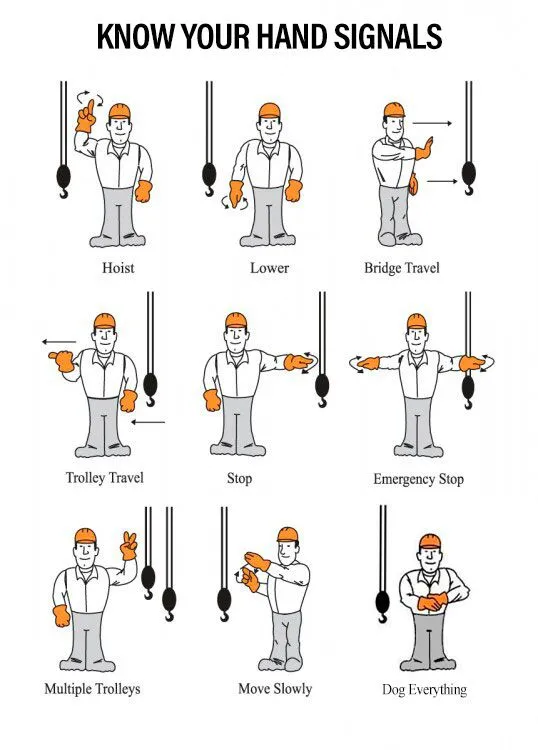What should you do before you use a hoist?—Hercules How-To
HERCULES HOW-TO: WHAT SHOULD YOU DO BEFORE YOU USE A HOIST?
What should you do before you use a hoist? If you’re a rigger, or have worked in construction, you’ve likely used some sort of hoist before. Hoists are mechanical devices use to lift, pull and hoist, and are equipped with a pulley. They’ve also been around for awhile—historians haven’t been able to pinpoint exactly when the first hoist was used, but even Leonardo da Vinci had a hoist design.
Since then, hoist technology has come a long way – hoists are available in manual, electric, hydraulic and even universal styles. They’re used in a number of different industries. Today, we cover more about hoists used for securing, lifting and rigging applications and what exactly you should do before you use one.
WHAT SHOULD YOU DO BEFORE YOU USE A HOIST? HAZARDS
We talk a lot about hazards, how to avoid them and prevent them on a job site. There are a number of hazards that present themselves at work – both chemical and physical. When rigging with hoists, there are a number of hazards there.
Some of the most common hazards are:
- Falling equipment, materials, etc.
- Electrical issues
- Loading hoist beyond it’s WLL or SLL, known as overloading
WHAT SHOULD YOU DO BEFORE YOU USE A HOIST? TRAINING
It’s important that anyone using the hoist, or operating rigging equipment in general, has proper training in hoist safety and operating procedures. Hoists are often used in rigging, and are commonly-known as a component for cranes. Hercules’ highly-skilled trainers teach a variety of courses that will prepare you to rig with hoists.
The Hercules Training Academy courses include:
- Fundamentals of Rigging
- Fundamentals of Rigging (with Practical)
- Offshore Rigger Banksman
- Confined Space Entrant & Attendant (CSEA)
- Fundamentals of Overhead Cranes
- Overhead Crane Operator
WHAT SHOULD YOU DO BEFORE YOU USE A HOIST? TYPES OF INSPECTION
According to the ASME (American Society of Mechanical Engineers), there are thee main types of inspection that rigger’s (or any end-user of hoisting equipment) have to do.
PREOPERATION INSPECTION
Before each shift, have a qualified person inspect hoisting equipment for:
- Ensure mechanisms operate properly – check for unusual sounds, and make adjustments as needed
- Hoist limit device, for electric or air-powered hoists without a load on its hook: The load block should inch on limit device, or run at a slow speed when on multi-speed or variable-speed hoists. Using travel-limiting clutches as a limit device? Follow inspection methods detailed in the travel-limiting clutch’s manual.
- Hoist’s braking system
- Check lines, valves and other parts of air system for leakage
- Check hooks & latches; ensure hooks are in accordance with ASME B30.10
- Check hoist rope for gross damage, and these features that could cause immediate hazards, including:
- Rope distortion: kinking, crushing, unstranding, bird-caging, main strand displacement and/or core protrusion
- General corrosion
- Broken or cut strands
- Number, distribution and type of broken wires (if visible)
- Check load chain for gross damage, and any of these conditions which can be hazardous for work. These are:
- Gouges, nicks, weld splatter, corrosion and/or distorted links.
- Test the hoist with the load in lifting and lowering directions, and watch the operation of the chain and sprockets. The chain should feed smoothly with the sprockets.
FREQUENT INSPECTION
Frequent inspections should happen continually, during use and rest periods. During frequent inspections, a qualified person will determine if issues found are hazards and whether the hoist should be removed from service temporarily, inspected further and repaired, or removed from service permanently and replaced.
During frequent inspections, inspect:
- Operating mechanisms for proper orientation, adjustment and unusual sounds
- Braking system
- Lines, valve and other parts of air systems for leakage
- Check hooks & latches; ensure hooks are in accordance with ASME B30.10
- Hoist limit device, for electric or air-powered hoists without a load on its hook: The load block should inch on limit device, or run at a slow speed when on multi-speed or variable-speed hoists. Using travel-limiting clutches as a limit device? Follow inspection methods detailed in the travel-limiting clutch’s manual.
- Check hoist rope for gross damage, and these features that could cause immediate hazards, including:
- Rope distortion: kinking, crushing, unstranding, bird-caging, main strand displacement and/or core protrusion
- General corrosion
- Broken/cut strands
- Number, distribution and the kind of visible broken wires
- Check load chain for gross damage, and any of these conditions which can be hazardous for work. These are:
- Gouges, nicks, weld splatter, corrosion and distorted links
- Test the hoist with the load in lifting and lowering directions, and watch the operation of the chain and sprockets. The chain should feed smoothly with the sprockets.
- Check rope/load chain reeving and make sure it complies with the manufacturer recommendation.
PERIOD INSPECTION
Periodic inspections can be conducted wherever your hoist is set up, as they don’t require the rigger to disassemble the hoist.
- Open or remove covers and other items to inspect components.
- A qualified, competent person will determine if conditions found during inspection make a hazard, or whether disassembly is required.
- Inspect the following for wear, corrosion, cracks and distortion:
- Ensure fasteners aren’t loose, or on the verge of coming loose
- Load blocks
- Suspension housings
- Hand chain wheels
- Chain attachments
- Clevises
- Yokes
- Suspension bolts
- Shafts
- Gears
- Bearings
- Pins
- Rollers
- Locking and clamping devices
WHAT SHOULD YOU DO BEFORE YOU USE A HOIST? WHEN DO I INSPECT?
We’ve covered the three types of hoist inspection required in Canada, according to the American Society of Mechanical Engineering (ASME). This is when you should conduct each type of inspection.
1. PREOPERATION INSPECTION
A visual inspection should be conducted before each shift. This inspection does not have to be recorded, but a designated, competent person should inspect the hoisting equipment.
2. FREQUENT INSPECTION
Frequent inspections, like pre-operatation inspection, are visual and don’t need to be recorded but should be done by a designated, competent person. Just how often are ‘frequent’ inspections, you ask?
A) Normal Service—Yearly
B) Heavy Service—Semiannually
C) Severe Service—Quarterly
3. PERIOD INSPECTION
Visual, period inspections should be conducted by a competent person who makes records of external coded marks on the hoist. This is acceptable identification in lieu of records. Periodic inspections should be done:
A) Normal Service—Yearly
B) Heavy Service—Semiannually
C) Severe Service—Quarterly
Since this article is about what to do before using a hoist, we’re going to focus on what your preoperation – or, preuse inspection should include.
- The pre-use inspection should be performed during each shift before the hoist is used.
- A competent, qualified person will determine whether conditions found during inspection could create a hazard and, if a more detailed inspection is required.
- Inspect the following:
- Operating mechanisms for proper operation, proper adjustment and unusual sounds.

WHAT SHOULD YOU DO BEFORE YOU USE A HOIST? KNOW THE ROPES
Before operating a hoist, it’s important to conduct an inspection before-hand. The inspection should consist of:
Rope Type: Ensure you select the proper type of wire rope. The wire rope you select will depend on the hoist type and the features of the load you will lift.
Are you familiar with the concept of rope stability before using that hoist? Hoists often use wire rope, which can kink, twist or become crushed if the wrong type or the wrong application is used.
Drum crushing is a type of rope deterioration that can happen with multiple layers of wire rope on a drum. Whoever inspects the wire rope must evaluate the potential for wire rope crushing. Inspections should detect points where crushing is more likely to happen, and the level of deterioration and appropriate course of action (ex. repair or replacement) can be made.
WHAT SHOULD YOU DO BEFORE YOU USE A HOIST? YOUR CHECKLIST
Before rigging or lifting with a hoist, know:
- The hoisting devices capacity
- The WLL of: the rope, slings and hardware, and the rigging hardware’s weight
Here are some basic tips from CCOHS for inspecting your hoist:
- Pre-Lift: Make sure both hooks (upper and lower) swivel, replace worn chain or wire rope and tag it so it can be removed from service.
- Post the SLL (safe load limit) in the hoist.
- Daily: Inspect hooks, rope, brakes and limit switches for wear and damage.
- Ensure swivels move freely and there are no cracks or breaks in the hook.
- Conduct periodic inspections according to manufacturer rules or legislation.
NEED A LIFT?
Hercules SLR offers everything you need for your hoist, crane or lifting project. We offer equipment inspections, repairs, maintenance and hoists from reliable, respected and durablebrands like Crosby, CM and Bronze & Blue.
FOR MORE INFORMATION ON OUR HOISTS & SERVICES,
CHECK OUT OUR BLOGS:
CROSBY QUIZ: CAN YOU PASS THIS HOOK INSPECTION QUIZ?
CM’S TIPS: CRANE & HOISTING IN HAZARDOUS AREAS
HERCULES SLR AT THE SABLE STRATEGIC WORKSHOP
Need more information on rigging services? We’ll lift you there.
Click here to learn more about our rigging services at Hercules SLR.
——————————————————————————————————————————————
The Hercules Group of Companies encompasses a wide portfolio of products and services across 7 diverse companies.


